Club 1497
As a member of Club 1497 you will have three exclusive fixed shipments, access to limited editions and you will be able to participate in special meetings and tastings.
Join
Isabel Negra - a tribute to this key woman from our estate - was born after our experience in Bordeaux; although over the years she has become part of Vins Pepe Raventós.
The 2018 vintage began with a drier and colder than usual autumn. With the arrival of winter also came rain. During the winter months it rained 216 mm (average of the last 25 years is less than 100 mm). Due to the cold during this period, bud break was late. The spring continued to be very rainy, with 212 mm of rainfall, which led to plant recovery, good vegetative growth and high fungal pressure, especially downy mildew. Right at flowering, the most sensitive period for mildew and powdery mildew, it rained every day. Working with phytotherapy, biological control and very low doses of copper, we managed to control the fungi. In August, we had the highest temperatures ever recorded on the farm, reaching 40 °C on August 4. This caused the cycle to be brought forward a few days. During the harvest, the temperature was rather cool and we had 4 days of rain. We carried out a very rigorous selection of grapes in the vineyard. During the entire crop year, we had a high rainfall of 654.9 mm (average of the last 20 years is 517.8 mm and that of the last 3 years of drought is 387.8 mm). The average temperature was 15.2 °C, similar to the average of the last 20 years.
.
The soils on the Estate are calcareous. The first layer comprises roots of up to 1 meter that live in the clay along with nutrients, organic matter and water. Second layer, from 1 meter down. This is where the plant meets the compact clays known locally as galera. Calcareous base rock encrusted with marine fossils.
The varieties we have planted are Xarel·lo and Bastard Negre, an ancestral variety that Pepe is trying to recuperate.
In winemaking, we go to the limit and from 2014 - in the garage of the Mas del Serral- we make natural parcel vinification of: “La Vinya del Mas”, “La Vinya del Noguer” and “ Les Terrasses del Serral”.
Vineyards planted in 1976 Vineyards of Cal Feset with calcareous soil, with clay texture, year of plantation: 1976
Coupage of 50% Sumoll and 50% Red Grenache; traditional red varieties of the area.
The vineyard is carried out on a strictly organic basis respecting the soil, the vineyards and its ecosystem to develop and maintain a balanced environment. We work with spontaneous and planted plant covers.
The maximum attention is focused on the vineyards, carrying out a meticulous work throughout the whole agricultural year, such as green pruning, winter pruning, making soldiers...so that the air circulates among the grapes minimizing the onset of diseases; Since once the grapes have matured in a healthy way, the wine can be allowed to develop with minimal intervention in the cellar; yeast, sugar, chemicals, or temperature control are not used in winemaking, making the process as natural as possible.
We work according to the biodynamic principles following the lunar calendar for the work on the vines, and we make our own preparations. We apply compost of the animals of our little farm.
All the work in the vineyard is done by hand and, when required, with the help of horses; 100% animal traction.
The grape was very healthy due to the drought throughout the entire cycle. The grapes go straight to the presses. Gentle crushing. Native yeast for a spontaneous fermentation of 15 days with the skins in inoxand amphora. During fermentation we do a little pigeage (punchingdown) to wet the cap without extracting too much tannin. Bleeding unpressed pulp. Spontaneous malolactic fermentation in inox followedby 8 months aging in barrels. Bottling and aging of at least 8 monthsin bottle. Not filtered or stabilized. We use low dose of sulphites.